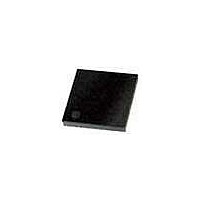PIC18F44K20-E/MV Microchip Technology, PIC18F44K20-E/MV Datasheet - Page 84

PIC18F44K20-E/MV
Manufacturer Part Number
PIC18F44K20-E/MV
Description
16KB, Flash, 768bytes-RAM, 36I/O, 8-bit Family,nanowatt XLP 40 UQFN 5x5x0.5mm TU
Manufacturer
Microchip Technology
Series
PIC® XLP™ 18Fr
Datasheet
1.PIC18F25K20T-ISS.pdf
(456 pages)
Specifications of PIC18F44K20-E/MV
Processor Series
PIC18
Core
PIC18F
Data Bus Width
8 bit
Program Memory Type
Flash
Program Memory Size
8 KB
Data Ram Size
512 B
Interface Type
I2C, SPI, SCI, USB, MSSP, RJ11
Maximum Clock Frequency
64 MHz
Number Of Programmable I/os
35
Number Of Timers
4
Operating Supply Voltage
1.8 V to 3.6 V
Maximum Operating Temperature
+ 125 C
Mounting Style
SMD/SMT
Package / Case
UQFN-40
Development Tools By Supplier
MPLAB Integrated Development Environment
Minimum Operating Temperature
- 40 C
Operating Temperature Range
- 40 C to + 125 C
Supply Current (max)
30 uA
Core Processor
PIC
Core Size
8-Bit
Speed
48MHz
Connectivity
I²C, SPI, UART/USART
Peripherals
Brown-out Detect/Reset, HLVD, POR, PWM, WDT
Number Of I /o
35
Eeprom Size
256 x 8
Ram Size
768 x 8
Voltage - Supply (vcc/vdd)
1.8 V ~ 3.6 V
Data Converters
A/D 14x10b
Oscillator Type
Internal
Operating Temperature
-40°C ~ 125°C
Lead Free Status / Rohs Status
Details
- Current page: 84 of 456
- Download datasheet (4Mb)
PIC18F2XK20/4XK20
5.4.3.1
At the core of indirect addressing are three sets of reg-
isters: FSR0, FSR1 and FSR2. Each represents a pair
of 8-bit registers, FSRnH and FSRnL. Each FSR pair
holds a 12-bit value, therefore the four upper bits of the
FSRnH register are not used. The 12-bit FSR value can
address the entire range of the data memory in a linear
fashion. The FSR register pairs, then, serve as pointers
to data memory locations.
Indirect addressing is accomplished with a set of
Indirect File Operands, INDF0 through INDF2. These
can be thought of as “virtual” registers: they are
mapped in the SFR space but are not physically
implemented. Reading or writing to a particular INDF
register actually accesses its corresponding FSR
register pair. A read from INDF1, for example, reads
the data at the address indicated by FSR1H:FSR1L.
Instructions that use the INDF registers as operands
actually use the contents of their corresponding FSR as
a pointer to the instruction’s target. The INDF operand
is just a convenient way of using the pointer.
Because indirect addressing uses a full 12-bit address,
data RAM banking is not necessary. Thus, the current
contents of the BSR and the Access RAM bit have no
effect on determining the target address.
FIGURE 5-10:
DS41303G-page 84
Using an instruction with one of the
indirect addressing registers as the
operand....
...uses the 12-bit address stored in
the FSR pair associated with that
register....
...to determine the data memory
location to be used in that operation.
In this case, the FSR1 pair contains
ECCh. This means the contents of
location ECCh will be added to that
of the W register and stored back in
ECCh.
FSR Registers and the INDF
Operand
INDIRECT ADDRESSING
x x x x 1 1 1 0
7
ADDWF, INDF1, 1
FSR1H:FSR1L
0
7
1 1 0 0 1 1 0 0
5.4.3.2
In addition to the INDF operand, each FSR register pair
also has four additional indirect operands. Like INDF,
these are “virtual” registers which cannot be directly
read or written. Accessing these registers actually
accesses the location to which the associated FSR
register pair points, and also performs a specific action
on the FSR value. They are:
• POSTDEC: accesses the location to which the
• POSTINC: accesses the location to which the
• PREINC: automatically increments the FSR by 1,
• PLUSW: adds the signed value of the W register
In this context, accessing an INDF register uses the
value in the associated FSR register without changing
it. Similarly, accessing a PLUSW register gives the
FSR value an offset by that in the W register; however,
neither W nor the FSR is actually changed in the
operation. Accessing the other virtual registers
changes the value of the FSR register.
FSR points, then automatically decrements the
FSR by 1 afterwards
FSR points, then automatically increments the
FSR by 1 afterwards
then uses the location to which the FSR points in
the operation
(range of -127 to 128) to that of the FSR and uses
the location to which the result points in the
operation.
FSR Registers and POSTINC,
POSTDEC, PREINC and PLUSW
0
2010 Microchip Technology Inc.
FFFh
E00h
F00h
000h
100h
200h
300h
Data Memory
Bank 13
Bank 14
Bank 15
through
Bank 0
Bank 1
Bank 2
Bank 3
Related parts for PIC18F44K20-E/MV
Image
Part Number
Description
Manufacturer
Datasheet
Request
R

Part Number:
Description:
Manufacturer:
Microchip Technology Inc.
Datasheet:

Part Number:
Description:
Manufacturer:
Microchip Technology Inc.
Datasheet:

Part Number:
Description:
Manufacturer:
Microchip Technology Inc.
Datasheet:

Part Number:
Description:
Manufacturer:
Microchip Technology Inc.
Datasheet:

Part Number:
Description:
Manufacturer:
Microchip Technology Inc.
Datasheet:

Part Number:
Description:
Manufacturer:
Microchip Technology Inc.
Datasheet:

Part Number:
Description:
Manufacturer:
Microchip Technology Inc.
Datasheet:

Part Number:
Description:
Manufacturer:
Microchip Technology Inc.
Datasheet:










